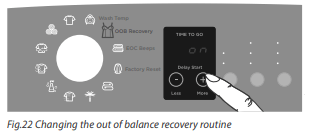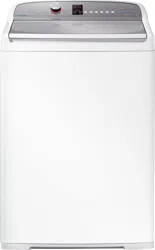Documents: Go to download!
User Manual
- User Manual - (English)
- Fisher & Paykel WL1068P1 CleanSmart™ 10kg Top Load Washing Machine Specifications Sheet - (English)
- Installation instructions
- Before you do your first wash
- CleanSmart™ safety features
- The unique CleanSmart™ wash
- Sorting and loading
- Detergent
- Fabric softener
- Wash Boost
- Wash cycles
- Wash cycle options.
- Customising wash cycles
- Changing pre-set options
- Caring for your washer
- Before you call for service
- Solving operating problems
Table of contents
User Manual
Installation instructions
Levelling instructions
It is IMPORTANT to level the machine to ensure good spin performance and effective detergent and fabric softener dispensing.
A spirit level is provided with your machine. Use this to level your machine, always placing it on a clean, flat surface. The machine is level when the bubble sits in the centre, within the two lines.
Your washer is equipped with self-locking feet to ensure they do not move once you have levelled your machine. To adjust the feet, pull down then twist to move them up or down. Note: after levelling, the corners of the washer should be clear of the floor and the machine must not rock in any direction.
1 If not already installed, fit the rubber inserts into all 4 feet on the base of the machine.
2 Move the machine to its final position using the top corners to manoeuvre the product into place (do not push on the centre front of the machine). We recommend a minimum clearance of 20 mm each side and 50 mm at the rear of the machine.
3 With the lid closed, place the spirit level at the centre back of the lid (near the control panel). Pull the machine out and adjust the rear feet (wind down) until the machine is level side to side when in position.
4 Open the lid. Place spirit level on the flat surface on the left side, inline with the centre of the bowl. Adjust the front left foot (wind down) until the machine is level.
5 Move the spirit level to the right side, in line with the centre of the bowl. Adjust the front right foot (wind down) until the machine is level, and does not rock. There should be equal weight on both front feet so that neither can be turned by hand when the machine is in position.
6 Place the spirit level at the centre front of the topdeck, forward of the lid lock slot. Check the machine is level. Move the spirit level around to all positions once more, checking the machine is level in all areas. Check the machine does not rock side to side, front to back, or corner to corner.
Important!
- Keep your spirit level for the next time you move or reposition your washer.
- If moving or transporting your washer in the future, ensure you tape the lid down beforehand.

Completing your installation
- Turn on the water and check all hose connections for leaks. Make sure there are no kinks in the hoses. Check the hose connections for leaks again after 24 hours.
- Uncoil the power cord, remove and discard the plastic pin cover, and plug into wall socket and turn the power on.
Installation test cycle
Your washer must be correctly installed before use. Check the machine’s installation and operation using the following procedure:
- Touch POWER to activate your washer.
- Touch both the KEYLOCK and OPTIONS buttons at the same time, and hold for three seconds.
- Touch START / PAUSE to start the installation test cycle.
- The machine will beep to signal the end of the installation test cycle. Any faults will be displayed on the screen (refer to the back of this user guide to help identify faults). If you need further assistance, please contact a Fisher & Paykel Customer Care Representative. Refer to page 41 for contact details.
Note: if there are no faults found, the washer will automatically turn off at the end of the installation test cycle.
Clothes washer safety
- This clothes washer is not intended for use by persons (including children) with reduced physical, sensory or mental capabilities, or lack of experience and knowledge, unless they have been given supervision or instruction concerning use of the appliance by a person responsible for their safety.
- The lid will be locked from the start of the cycle until the cycle is complete for safety reasons.
- To open the lid during operation, you must touch START /PAUSE.
- Supervise children at all times to ensure they do not play with the washer.
- The only user-removable parts of the washer are the inlet hoses and dispenser funnels. No other parts are designed to be removed by anyone other than a Fisher & Paykel Authorised Repairer.
Important!
If you are using an extension cord or a portable electrical outlet device (eg multi-socket outlet box), ensure that it is positioned so that it does not come into contact with water or moisture.
Before you do your first wash
Machine information
Specifications

- Electrical supply: 220 – 240 V, 50 Hz Sinusoidal, 10 A
- Inlet water static pressure: Max. 1 MPa (150 psi), Min. 34 kPa (5 psi)
- Inlet water flow rate at tap: Min. 6 litres/ min
- Standpipe height: 850 – 2400 mm
Note: the exact height of your washer is dependent on how far the feet are extended from the base of the machine
Detergent
Although your CleanSmart™ is a top-loading machine, this High Efficiency washer has been designed for use with liquid Low Sudsing, ‘HE’ or ‘Front Loader’ type detergent.
CleanSmart™ offers a detergent dispenser for your convenience, located on the front, left hand side of the top deck.
For the correct detergent dose, please follow the manufacturer’s directions outlined on the detergent package.
Pour the detergent down the detergent dispenser.

Using your washer
The buttons require only a gentle touch to activate.
- Touch POWER to activate your CleanSmart™ washer.
- Select your desired wash cycle by turning the SmartTouch Control Dial. The wash cycle icons will illuminate as you turn the dial, showing which cycle is selected.
- High Efficiency - this allows you to select either a high efficiency (High Efficiency On – to save water) or conventional cycle (High Efficiency Off – to use more water when needed) .
- Choose your wash options. For example, if you would like a warm wash temperature, touch the WASH TEMP button until the light next to ‘Warm’ is lit. If you wish to use fabric softener, ensure SOFTENER is selected in OPTIONS (refer to pages 23 and 24).
- Touch START / PAUSE to start the cycle and let CleanSmart™ do the rest for you. The washer will start to fill with water and will automatically select the correct water level and wash action for your load. Please note: constant interruptions to the cycle, such as touching START / PAUSE will increase the time taken to complete the cycle and may result in poorer wash performance.
- Use KEYLOCK to lock the buttons on the control panel, preventing them from being activated accidently ).
- DELAY START allows you to delay the start of your wash by 5 mins up to 18 hours.
- For best fabric and colour care, remove your clothes as soon as the cycle has finished.
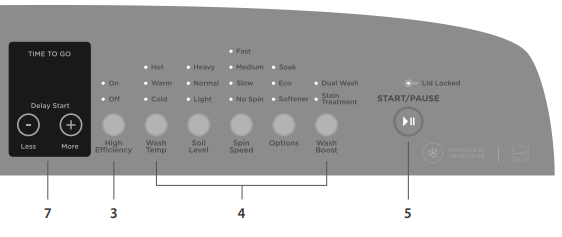
CleanSmart™ controls
SmartTouch Control Dial
The SmartTouch Control Dial provides easy and efficient cycle selection. As you rotate the dial, the cycle selected will be illuminated, along with the default settings for that cycle on the right of the control panel.
SmartTouch buttons
The smooth, easy clean buttons require only a gentle touch to activate. Use these to power your machine on and off, start and pause your washer, select your wash options, activate keylock and programme a delay start.
Digital display screen
The digital display screen provides feedback on how long the wash cycle has to go to keep you informed throughout the cycle. The screen also displays your DELAY START selection, should you choose one. The delayed time remaining will show on the screen until the machine starts. The screen will also display messages to help you with the overall running of your machine.
Time to go
Your CleanSmart™ washer displays approximately how many minutes the cycle has remaining, so that you can tell at a glance when your washing will be finished. Once you have selected your wash cycle and options, the time the cycle will take to complete will be displayed. Please be aware that a number of factors influence the overall cycle time, eg the water flow rate and load size and cycle selection, therefore times will vary.
Keylock mode
Keylock can be used to lock the buttons on your CleanSmart™ when not in use. This will avoid accidental button pushes from items left on the lid of the washer (eg washing baskets) and also from any little fingers.
To turn Keylock mode ON or OFF:
- Touch and hold the KEYLOCK button for 2 seconds
Note: when activated, the light above the KEYLOCK button is illuminated.
If Keylock mode is activated:
- To turn your washer on, touch and hold the POWER button for 2 seconds. This will activate the display panel. Keylock will remain activated but let you select your wash cycle options and start the cycle.
- To PAUSE your washer at any time during the cycle, touch and hold the PAUSE button for 2 seconds or touch the PAUSE button twice in quick succession.
- To STOP your washer and power off, touch the POWER button twice in quick succession or touch and hold the POWER button for 2 seconds.
CleanSmart™ safety features
Lid lock
The lid of your CleanSmart™ washer is locked during the wash cycle, ensuring safety for you and your family while it is operating.
The ‘Lid locked’ light (above the START / PAUSE button) is illuminated when the lid lock is activated, letting you know at a glance if you can open the lid or not.
To unlock the lid at any time during the cycle touch START / PAUSE.
The lid will be locked from the start of the wash to the end, unless START / PAUSE is pressed.
If the lid is left open, your CleanSmart™ washer will be unable to lock the lid, and the cycle will be halted. The machine will beep to alert you and display a warning message on the screen. If this occurs, ensure that the lid is closed and touch START / PAUSE.
Important!
Do not put anything down the lid lock slot in the top deck of your machine.
Do not try to disable the lid lock.
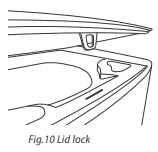
Auto drain
- Unsupervised clothes washers filled with water can present a drowning hazard to small children In order to minimise any risk of this type of accident, your CleanSmart™ has been pre-programmed to know when this potential hazard is created and drain the wash water to a safe level.
- If you pause your CleanSmart™ at any time during the wash cycle when there is water in the bowl, the machine will activate the AUTO DRAIN function after 3 minutes. This will drain the water in the wash bowl to an acceptable level, minimising any potential hazard.
- A message (“Adr”) will be displayed on the digital display while AUTO DRAIN is in operation. The cycle can be restarted at any time by touching START / PAUSE.
The unique CleanSmart™ wash
The CleanSmart™ washer has two modes of washing, HE ‘On’ (High Efficiency) and HE ‘Off’ (Conventional). Both modes start the same way, with a Detergent Activating wash.
Detergent Activating wash
CleanSmart™ fills the bowl at the selected water temperature, with just enough water so the clothes are saturated. This small amount of sudsy water flows through the clothes, up a specially designed portal and back onto the clothes in a waterfall effect. This thoroughly dissolves and activates the detergent.
High Efficiency On (High Efficiency mode)
In the High Efficiency mode the CleanSmart™ then fills with just enough cool water to lift the clothes off the low-profile agitator so that when it rotates, the clothes gently roll over each other. This wash gives you the benefit of water savings, using similar quantities of water to most front loaders.
High Efficiency Off (Conventional mode)
The Conventional mode is the immersion wash all top-load washer users are familiar with. However, this mode still uses less water than that of other top loaders which utilise the immersion wash. After the Detergent Activating wash the CleanSmart™ fills with cold water until the clothes are submerged, and gently turns the clothes over. We recommend this mode when the dilution effect of water can solve or prevent common wash problems. For example, when dye or colour run can be a problem (ie new, dark-coloured garments), or when washing sandy towels.
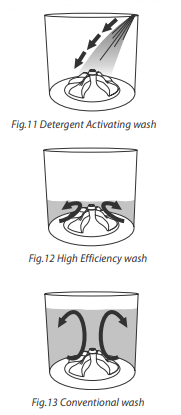
Some cycles can be used in both modes, whilst others are available in only one.
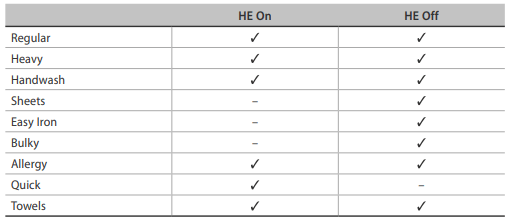
These two wash modes mean that your CleanSmart™ washer gives you the best of both worlds, accommodating any laundry situation.
Sorting and loading
When sorting your wash load and loading your CleanSmart™ there are some important things to consider:
Sorting
- Care labels provide valuable information about the fabric type and how the garment should be washed.
- Sort items according to what they are soiled with – some soils, like mud and blood are best washed in cold water. Oily soils (eg some foods and marks on shirt collars) are best washed in warm water.
- Always separate coloured items from whites, especially when they are new.
- Some items are lint givers (eg towels, nappies), while others are lint collectors (eg black trousers, synthetic socks). Always wash lint givers and collectors separately.
(Lint givers - Lint collectors)
Towels - Synthetics, eg polar fleece
Flannelette sheets - Corduroy
Nappies - Polyester cottons
Loading
- CleanSmart™ is more efficient when washing larger loads. So try to wash larger loads – without packing clothes too tightly into the wash bowl. Wait till you have at least 4 or 5 items before you do a wash.
- For the best wash, only fill the machine to the top of the stainless steel bowl (ie to just underneath the plastic ring).
- Always separate out your sheets and wash them on their own using the specifically designed SHEETS cycle. Your sheets will wash better and last longer this way. Load sheets in parcels to the side of the low profile agitator and in layers around the bowl. Do not load sheets across the centre of the low profile agitator.
- Never wrap items around the low-profile agitator like a snake, or spread them over the agitator. Instead, place them in as loose parcels. This will help prevent tangling and out of balance issues.
- For best results and longevity, always separate out your towels and wash them on their own using the specifically designed TOWELS cycle.
You may notice that your CleanSmart™ clothes washer behaves differently from your previous washer. Your CleanSmart™, like all High Efficiency washers, has fully automatic water level selection. This means that, like front loaders, the selection of the water level is left entirely up to the washer. This ensures optimum wash performance and water savings. Should you wish to use more water, simply select High Efficiency OFF (where available). Refer to ‘High Efficiency Off’.
Sorting and loading explained
Your CleanSmart™, like front loading machines, uses much less water and energy than traditional top loading clothes washers. It is important that you sort your wash load to ensure optimum wash performance.
Sheets – Separate out sheets and duvet covers and use the SHEETS cycle which has been especially designed for these items. Ensure that duvet/ doona covers are buttoned or domed closed before placing in the machine. To get the best possible wash, load these items individually as ‘parcels’ toward the outer edge of the bowl (ie to the side of, not directly across the low profile agitator) and in layers (two items per layer).
Coloured items – Dye or colour run can be a problem with High Efficiency washers, so separate highly coloured garments especially when they are new and have not been washed many times. Choose the REGULAR cycle, High Efficiency OFF and COLD wash temp. Most dye transfer occurs when clothes are left too long in the machine at the completion of the cycle so try not to leave your coloured clothes lingering in the washer.
Bulky items – Duvets/doonas, sleeping bags, water-proof items, ski jackets, blankets and throws are all items which tend to behave unusually in a clothes washer. The lighter items tend to float, while a large blanket can get very heavy and make spinning difficult. Your CleanSmart™ has a specific BULKY cycle option designed to help take care of these washing challenges.
Creasables – When you are concerned about creasing or wrinkling of items we recommend you use the EASY IRON or HANDWASH cycles. Alternatively, select one of the Conventional cycles (ie High Efficiency OFF). The extra water used by these cycles will help to reduce creasing. Reducing the SPIN SPEED of the wash may also help.
Jeans – These heavy items can be responsible for damaging other items in the wash and require special attention when it comes to washing them. We feel that they should be washed separately using the REGULAR cycle, High Efficiency OFF and COLD wash temp, or using the BULKY cycle (with COLD wash temp).
Hint: turn your jeans inside-out before washing to help maintain their appearance.
Soil – Very dirty, sandy or linty loads are best washed separately to prevent transfer onto other garments. It may be that you have new towels that create lots of lint, or very sandy beach gear. We suggest selecting High Efficiency OFF in these circumstances or selecting the fabric softener rinse as this will give an extra deep rinse (ie ensure the SOFTENER option is selected).
Note: there is no need to add fabric softener to the dispenser in this instance. Very dirty loads should be washed separately. HEAVY soil level should be selected to provide some extra agitation. We recommend selecting the DUAL WASH option for extra dirty loads.
Delicates – To take extra special care of delicate items, we suggest using the HANDWASH cycle.
Detergent
Choosing the right detergent
Your CleanSmart™ is a High Efficiency clothes washer and needs a Low Sudsing Detergent to prevent oversudsing problems. This is the same type of detergent Front Loaders use and is labelled, “Low Suds”, “Matic”, “High Efficiency” or “HE”.
We recommend the use of liquid detergents in most washing situations to achieve the best results. This is particularly important when washing dark garments.
When washing woollens use a wool detergent but use it sparingly as these are usually very high foaming. Do not use soap flakes or granulated soap powders.
How much detergent?
Use the instructions stated on the detergent label as a guide to the correct amount to use. The correct amount of detergent will vary depending on the amount of soil in your clothes and the size of your load. Jeans and work clothes may need more and towels less.
- If you have over-foaming problems, reduce your dosage.
- If your clothes are not clean enough, try using a bit more.
Where do I put my detergent?
Pour your detergent into the detergent dispenser, located on the left side of the washer. We recommend that you measure your detergent first.
You will notice that most of the detergent placed in the dispenser will fall into the machine. It will remain in an area separated from your clothes until the machine begins to fill. As the washer fills, the dispenser will be flushed of any residue. The detergent is then mixed with water at the bottom of the machine, dissolving and activating it to ensure optimum wash performance.
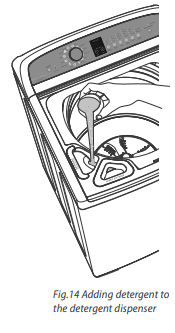
Fabric softener
Choosing the right cycle
If you wish to use fabric softener you will need to select SOFTENER by touching the OPTIONS button which will give you a deep rinse. If the SOFTENER option is not selected, the fabric softener will not be dispensed correctly.
Note: a small volume of water remaining in the dispenser at the end of the cycle is normal.
Adding the fabric softener
Always refer to the fabric softener package for the manufacturers recommended dosage. Measure the softener out into the cap and pour into the fabric softener dispenser. The softener will remain in the dispenser until the deep rinse where water flushes it into the bowl.
Note: if you fill beyond the MAX mark, the fabric softener will dispense into the bowl prematurely and may stain clothes, and also contribute to scrud (described below).

Cleaning the dispenser
The dispenser may need cleaning periodically. Please refer to page 31 for advice about cleaning the dispenser.
Scrud
Scrud is the name of the waxy build-up that can occur within any washer when fabric softener comes into contact with detergent. This build-up is not brought about by a fault in the machine.
If scrud is allowed to build up in the machine it can result in stains on clothes or an unpleasant smell in your washer. Scrud can be kept under control by using the BOWL CLEAN cycle regularly .
If you wish to use fabric softener we recommend to:
- Use it sparingly. Measure it carefully to ensure you do not fill above the MAX level of the dispenser.
- Use one that is of a thinner consistency.
- Clean the dispenser as soon as the cycle has finished.
- Clean your machine regularly using the BOWL CLEAN cycle.
- Cold water washing increases the chance of this build-up occurring. We recommend a warm or hot wash at regular intervals, eg every 5th wash.
Wash Boost
Wash Boost options
Your CleanSmart™ washer has an extra dispenser located on the right hand side called the Wash Boost dispenser. You can use this dispenser to boost your wash performance in two ways:
Stain Treatment
The STAIN TREATMENT option allows you to add a liquid in-wash fabric stain remover to help combat tough stains. The liquid treatment is released into your wash at just the right time to work on any stains present. Short soaks are included in the wash to effectively boost stain removal. For the stain remover to be dispensed correctly, ensure STAIN TREATMENT is selected before starting your wash.
Note: Pre treatment products, such as concentrated spray-on fabric stain removers must NOT be used in the Wash Boost dispenser.
Dual Wash
For extra dirty loads you can perform a DUAL WASH. Your CleanSmart™ will complete a double wash; the first is an initial wash to loosen soil and get the wash started using a cool water temperature to ensure any stains are not “set in”. Detergent for this part of the wash should be placed in the detergent dispenser. The second part is a complete wash to remove all traces of dirt. The liquid detergent for this part of the wash should be placed in the Wash Boost dispenser. When you feel your load requires extra washing, ensure DUAL WASH is selected from the WASH BOOST options.
Note: you can use the manufacturers recommended dose of detergent in each of the detergent and Wash Boost dispensers. However, reduce the amount if you have problems with over-sudsing.
Important!
The Wash Boost dispenser is NOT designed to dispense bleach into your wash. The bleach will not be dispensed correctly and may damage your clothing. Only liquid detergent or liquid in-wash fabric stain remover must be used (ie no powder).
Adding the liquid in-wash fabric stain remover or liquid detergent
Liquid in-wash fabric stain remover, or liquid detergent only, must be used in the Wash Boost dispenser. Refer to the manufacturers instructions on the package for the correct dosage. Add the liquid in-wash fabric stain remover or liquid detergent to the dispenser before starting the wash cycle ensuring you do not exceed the MAX LEVEL shown on the dispenser.
Note: a small volume of water remaining in the dispenser at the end of the cycle is normal.
Cleaning the dispenser
The dispenser may need cleaning periodically.
Wash cycles
Your CleanSmart™ washer has a number of wash cycles to suit your laundering needs. Selecting the most appropriate cycle for each particular wash load will help ensure you get the best possible wash result.
Wash cycles explained

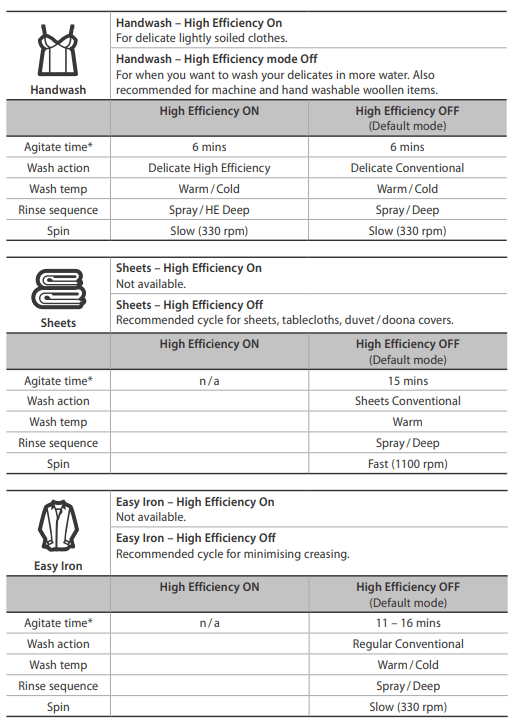
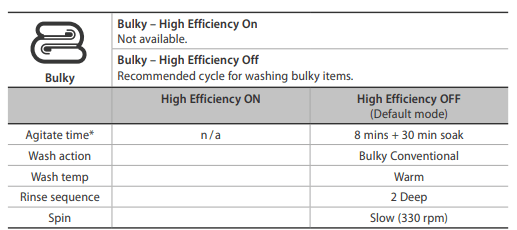
The BULKY cycle takes special care of bulky items. Bulky garments and bedding wash most effectively when they can move freely. Ensure that there is sufficient room in the bowl for the load to move during the wash.
When washing a single bulky item add a large beach towel to the wash, to ensure the load is balanced for an effective spin.
Note: we recommend that you do not wash woollen duvet/ doona inners, or any other item marked “dry clean only” in your CleanSmart™ washer.
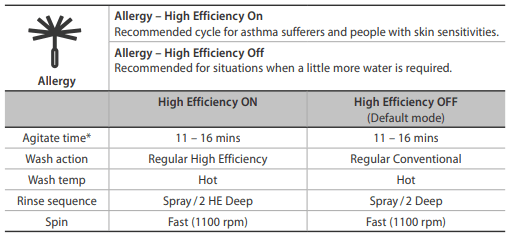
Note: the ALLERGY cycle is not recommended for garments prone to colour run.
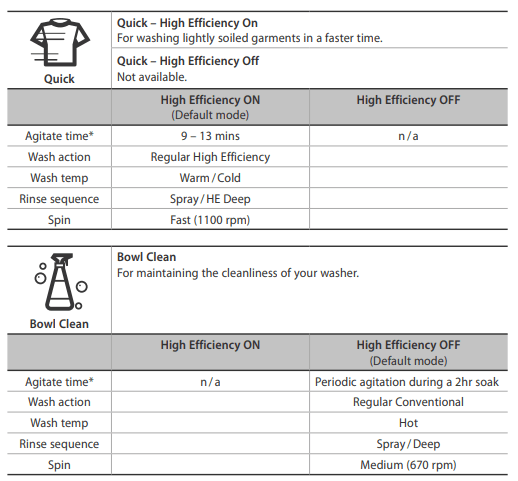
Cleaning the inside of your washer regularly is important. Your washer will remind you to complete a BOWL CLEAN cycle every 100 cycles (the BOWL CLEAN cycle icon will flash to alert you) or we recommend you complete this cycle 5 – 6 times a year

If you wish to change any of the wash options while your CleanSmart™ is running, press START / PAUSE then select the required option.
*Refers to the agitation time in the ‘wash’ part of the cycle, not the total time taken to complete a cycle. In addition, the actual wash time depends largely on the size of your wash load, therefore can vary by a number of minutes
Wash cycle options.
Wash cycle options explained
Once you have selected your wash cycle you may wish to change the default wash options.
High Efficiency
This option lets you choose between a High Efficiency (ie High Efficiency On) and Conventional (ie High Efficiency Off ) mode of washing. Some cycles can be used in either of the modes, or only one, depending on what is best for your clothes
Wash Temp
CleanSmart™ offers five wash temperatures and an additional setting, CONTROLLED COLD.

Simply touch the WASH TEMP button to increase or decrease the wash temperature.
Note:
- The temperature option selected determines the temperature of the first phase of the two-part wash system, known as the Detergent Activating Wash (with the exception of the ALLERGY cycle where both parts of the wash are hot).
- Some temperatures are not available on some cycles as a safeguard for your clothes (eg HOT and WARM /HOT on the HANDWASH cycle).
Hint: if a hot wash is required, where both phases of the wash system are hot, you must select the ALLERGY cycle, or the SHEETS cycle and HOT temperature.
Controlled Cold
The temperature of cold tap water varies widely, depending on your location and the season. The lower the cold water temperature, the less effective the cold wash becomes. To help with this issue we have developed CONTROLLED COLD which adds a small amount of warm water, when necessary, to raise your cold water wash to approximately 20°C. This will ensure that you receive a more effective wash in cold water. Cold Tap (“tAP”) is the default COLD setting on your washer. If you wish to use the CONTROLLED COLD setting as the default COLD setting.
Soil level
Your clothes and other washable items sometimes need more or less cleaning than others. The SOIL LEVEL option lets you adjust the wash to suit the amount of soil in your load. For example, for dirty clothes, select HEAVY and for items that are only lightly soiled, select LIGHT. This adjusts the wash time accordingly to give the load the right amount of agitation in order to remove the soil.
Spin Speed
Your CleanSmart™ washer offers three spin speeds: FAST (1100 rpm), MEDIUM (670 rpm) and SLOW (330 rpm), plus an additional SPIN HOLD option. Simply increase or decrease your spin speed by touching the SPIN SPEED button. SPIN HOLD will pause the washer at the end of the rinse, allowing you to remove drip-dry items before you proceed the washer to its final spin (touch START / PAUSE to start the spin).
Wash Boost
If you have stains in your wash load that you need to treat or wish to perform a double wash, select STAIN TREATMENT or DUAL WASH from the WASH BOOST options.
Options
Soak
The SOAK option provides a two hour soak during the middle of the wash phase of the cycle.
The machine will then complete the rest of the cycle. During SOAK, the washer will agitate for a few seconds every minute. To perform a soak during a cycle, simply select SOAK from the OPTIONS menu.
To exit SOAK, touch START / PAUSE and turn the dial to select RINSE. Change the SPIN SPEED if necessary (eg select SLOW if washing handwash only, delicate, or creasable items) and touch START / PAUSE.
Note: if the soak option is selected on a QUICK cycle, the soak time will be one hour only.
Important!
Ensure items are colourfast before using soak.
Eco
Use the ECO option to save water. The ECO option uses a spray rinse which has been specially designed to use at least 25% less water than a traditional rinse. Use this option when you want to use less detergent and less water. However, if you have low water pressure or sensitive skin it is better to use a traditional rinse.
Note: the ECO option is available on selected cycles only. If ECO is not available for a cycle, your washer will skip over it in the OPTIONS menu.
Softener
If you wish to use fabric softener, ensure SOFTENER is selected. This will adjust the rinse part of the cycle so that softener is dispensed correctly.
Delay Start
The DELAY START option can delay the start of the wash cycle between 5 minutes and 18 hours. This can be useful to time your washing to finish when you arrive home from work, or to start once you have finished in the shower. Simply touch the MORE  button to increase the delay time, and LESS
button to increase the delay time, and LESS  button to decrease the time, or turn DELAY START off. Touch START / PAUSE to confirm your selection and start the countdown.
button to decrease the time, or turn DELAY START off. Touch START / PAUSE to confirm your selection and start the countdown.
Note: we suggest that you avoid using DELAY START for damp, non-colourfast items as this may cause dye run to occur.
Customising wash cycles
To customise a cycle
You can program your CleanSmart™ washer to remember the wash options you prefer for each wash cycle. For instance, you may want to set the TOWELS cycle to a WARM /HOT wash or set the HEAVY cycle to include a SOAK.
- Press POWER.
- Turn the dial to select the wash cycle you wish to customise.
- Touch and hold the button of the option you want to customise, eg WASH TEMP for 3 seconds. You will hear 2 quick beeps and the wash cycle icon will flash. The screen will display “SET”.
- Select your preferred setting for this option, and any other options you wish to customise for this cycle.
- Touch the START / PAUSE button to store your customised cycle. A long beep will sound to confirm that your changes have been saved.
To change your customised wash cycle simply repeat these steps.

Changing pre-set options
Option Adjustment mode
After using your washer a number of times you may want to fine tune some of the options to suit your wash needs.
There are a number of pre-set options which can be altered:
- The wash temperatures, including changing the COLD wash temperature to CONTROLLED COLD.
- The out of balance recovery routine.
- The number of beeps at the end of the cycle.
- Resetting to factory default settings.
To enter Option Adjustment mode
- Turn the machine on at the wall but do not touch POWER. Touch and hold the KEYLOCK and START / PAUSE buttons together for 3 seconds. You will hear 3 quick beeps indicating you have entered Option Adjustment mode and the machine will show the default setting for the COLD wash temperature. The diagram shows how the wash cycle icons relate to the options you can change.
- Use the dial and buttons on the control panel to make your changes to the pre-set options.
- Touch POWER to return to normal mode when you have finished modifying your options. Your washer will automatically remember your changes.
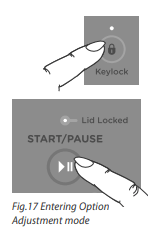
Adjusting your options
1 Enter the Option Adjustment mode.
2 The diagram below shows how the wash cycle icons relate to the pre-set options you can change. It also shows what will be displayed when you first enter Option Adjustment mode. Options you can change are accessible using the HEAVY, HANDWASH, SHEETS and EASY IRON cycles only.
Use this diagram to help you adjust the options, eg select the HEAVY cycle to modify the wash temperature, select the HANDWASH cycle to change the out of balance (OOB) recovery process, and so on.

3 Use the DELAY START buttons underneath the digital display to scroll through the available settings of your selected option.
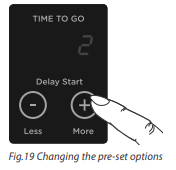
Wash temperatures
All wash temperatures can be individually adjusted if you think they are too hot or too cold.
Note: the hot temperature will be the same as the hot water supply temperature.
To modify the wash temperature:
- Enter Option Adjustment mode.
- Select the HEAVY cycle.
- Select the wash temperature you want to adjust, eg WARM, by touching the WASH TEMP button. The digital display screen shows the current setting.
- Touch the MORE
 or LESS
or LESS  button to increase or decrease to the desired temperature. Each increment is equal to approximately 0.5°C.
button to increase or decrease to the desired temperature. Each increment is equal to approximately 0.5°C.

Controlled cold
If your incoming cold water temperature is very low you will get a less effective wash. The CONTROLLED COLD option solves this problem by adding a small amount of hot water to raise the temperature of the wash to approximately 20°C.
To programme the CONTROLLED COLD temperature option:
- Enter Option Adjustment mode.
- Select the HEAVY cycle.
- Select COLD wash temperature by using the WASH TEMP button (if not already selected).
- The digital display shows the temperature adjustment possible. The default setting is “tAP”, ie the temperature of the incoming water from the cold cylinder.
- Touch the MORE
 button until “O” is displayed. Your washer will now control the cold temperature to approximately 20°C. Note: each of the remaining settings equals an approximate increase or decrease of 0.5°C from this point.
button until “O” is displayed. Your washer will now control the cold temperature to approximately 20°C. Note: each of the remaining settings equals an approximate increase or decrease of 0.5°C from this point.

Note: if you always use COLD or CONTROLLED COLD water, we recommend that a WARM or HOT wash be used regularly, eg every 5th wash should be at least a warm one to maintain the cleanliness of your machine.
Out of balance recovery routine
When your washer is spinning it can sense if the wash load is out of balance. If an out of balance load is detected, the machine will stop and re-try spinning one more time. If it still senses an unbalanced load there are two options the machine can take.
Automatic recovery OFF (default setting)
Your washer will stop, beep, and show “out-oF-bAL” in three phases on the display screen. You must redistribute the load more evenly yourself and touch START / PAUSE to resume the cycle.
Use this option if you wish to conserve water.
Automatic recovery ON
Your washer will try to automatically correct the out of balance load. It will fill with water and agitate to redistribute the load before trying to spin up again.
To change the out of balance recovery routine:
- Enter Option Adjustment mode.
- Select the HANDWASH cycle.
- Touch the MORE
 button to turn AUTOMATIC RECOVERY on or off.
button to turn AUTOMATIC RECOVERY on or off.
End of cycle beeps
The beeps signalling the end of the cycle can be increased or decreased. The default setting is 5 beeps.
To modify the number of beeps sounding at the end of the cycle:
- Enter Option Adjustment mode.
- Select the SHEETS cycle.
- Touch the MORE
 or LESS
or LESS  button to increase the number of beeps, or for no beeps to sound at the end of the cycle.
button to increase the number of beeps, or for no beeps to sound at the end of the cycle.
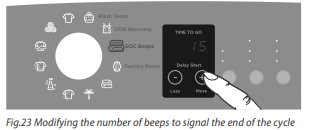
Factory reset
You can reset your washer to the default settings it left the factory with.
To reset your washer to its factory settings:
- Enter Option Adjustment mode.
- Select the EASY IRON cycle.
- The display will show “rSt”. Touch START / PAUSE for 3 seconds to reset your washer to its factory settings.
Note: this action will reset the washer to the default settings, exit Option Adjustment mode and then restart the washer in normal operating mode.
Touch POWER to exit if you do not wish to reset your washer.

Remember, to save changes and exit from the Option Adjustment mode at any time (ie to return to normal operating mode), touch the POWER button.
Caring for your washer
When you have finished using your washer
- Turn off the taps to prevent the chance of flooding should a hose burst.
- Unplug the machine from the power socket.
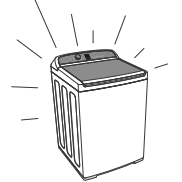
Cleaning your CleanSmart™
Before you start cleaning your CleanSmart™ washer, ensure that it is disconnected from the power (ie unplug the machine from the power socket).
Cleaning the control panel, topdeck and lid
Use a soft damp cloth to wipe all surfaces, and wipe dry. Avoid using chemical or scouring cleaners, as these will damage the paint and plastic surfaces of your washer.

Important!
The SmartTouch Control Dial and soft close lid are not designed to be removable for cleaning. Do not attempt to remove the dial or lid.
Cleaning the detergent, fabric softener, and Wash Boost dispensers
Wipe out the detergent dispenser with a damp cloth. The funnels (tops) of both the fabric softener and Wash Boost dispensers click off easily. Simply place a finger down the centre and lift. The fabric softener and Wash Boost dispenser compartments are not removable and need to be wiped clean periodically. If the siphon tube on either dispenser looks partially blocked use a cotton bud to clean.

Cleaning the inside of your washer
It is important that you occasionally clean the inside of your machine. Your CleanSmart™ has a BOWL CLEAN cycle specifically for this purpose and will remind you every 100 cycles to run this cycle (the BOWL CLEAN cycle icon will flash to alert you), or we recommend completing this cycle 5 – 6 times a year. We suggest that you do not have any items in the washer when you run this cycle.
Cleaning steps
- Add approximately 2 full scoops of a good quality powdered detergent directly into the detergent dispenser.
- Touch POWER to turn your machine on and select the BOWL CLEAN cycle.
- Touch START / PAUSE to start the cycle.
Cleaning your low-profile agitator
If your low-profile agitator becomes stained we recommend you use household bleach to clean it. Ensure you wear gloves. Tip a small amount of household bleach onto a soft cloth and apply to the stain. Be careful to avoid metal surfaces of your machine. Leave it to soak in for 10 minutes and repeat. Then put your CleanSmart™ washer through the BOWL CLEAN cycle to remove any residual bleach ).
Automatic lint disposal system
With CleanSmart™ there is no need to remove messy lint filters. Your CleanSmart™ has a self cleaning lint disposal system. It automatically separates the lint from the wash water as it washes. The lint becomes trapped between the inner and outer bowls and is flushed out at the end of the wash.
Nappy sanitisers /bleach
Nappy sanitisers and bleach are very corrosive to metal surfaces. DO NOT use your CleanSmart™ to soak items in bleach or sanitiser, or tip the contents of a nappy bucket into your machine. Rinse and wring items out thoroughly before placing them in the machine.
Before you call for service
Please read the following pages before you call for service.
Your CleanSmart™ is capable of diagnosing its own problems. If your washer gives a musical series of beeps every 5 seconds it is telling you that it has a problem which you can correct yourself with the help of the checklists on the following pages.
Your machine sounds a musical series of beeps* every 5 seconds and displays a user warning on the screen:
"no hot” (no hot – I am not getting any hot water)
- Check that the hot water supply has been turned on.
- Your hot water supply may not be hot enough to maintain the selected water temperature.
- Select a lower wash temperature.
- Check that the inlet hose filter is not blocked.
- Check that the inlet hoses are not kinked or squashed.
- Check that the inlet hoses have been connected to the correct taps.
- The flow rate of the supply water may be too slow.
"no Cld” (no cold – I am not getting any cold water)
- Check that the cold water supply has been turned on.
- Your cold water temperature may exceed the recommended limits.
- Check that the inlet hose filter is not blocked.
- Check that the inlet hoses are not kinked or squashed.
- Check that the inlet hoses have been connected to the correct taps.
- The flow rate of the supply water may be too slow.
"no tAP” (I am not getting any water)
- Check that the taps have been turned on.
- Check that the inlet hose filters are not blocked.
- Check that the inlet hoses are not kinked or squashed.
- Check to see if the drain hose is too low or is pushed into the standpipe too far. This will cause the water to siphon out of the machine .
- The flow rate of the supply water may be too low.
"out oF bAL” (out of balance)
- Wash load is out of balance.
- Ensure the machine is stationary and manually redistribute the load.
- Check your machine is level.
* The beeps are the same sound your washer makes when you turn it on at the wall.
"Sud LOC” (suds lock – I have too many suds)
- Your machine has a suds build-up. Too much detergent may have been used for the amount of soil in the load.
- Ensure that you are using a HE, Low Sudsing, Matic or Front Loader type detergent.
- Wait for suds to dissolve (about 20 minutes).
- Restart the cycle from the start (do not add more detergent).
- Check the standpipe height does not exceed 2400 mm.
- If using the DUAL WASH option, reduce the amount of detergent placed in the detergent dispenser.
"Lid LOC” or “Lid OPn” (lid lock or lid open – I can’t lock the lid or the lid is open)
- Check that the lid is closed.
- Press START / PAUSE ).
- If the symptom persists, call your Fisher & Paykel Authorised Repairer.
"too FUL” (too full – I am overloaded)
- Your machine is overloaded and cannot continue the cycle.
- Ensure the machine is stationary and remove items until the remaining ones can move freely.
- Check that the machine is not siphoning (refer to page 3).
Single beep every second and...
A number shows on the display (this is a fault code)
- Turn your machine off at the wall.
- Wait 1 minute and turn it back on.
- Check your machine is level.
- Remove load and retry.
- Perform a RINSE cycle.
- If the fault re-occurs repeat steps 1 and 2.
If the machine still will not work, call your Fisher & Paykel Authorised Repairer to arrange service
Solving operating problems
Pressing POWER does not turn on machine
- Is the power switched on at the wall?
- Unplug from wall. Wait 60 seconds, plug back in, turn on and try again.
- Could household power supply be at fault? Try plugging in another appliance.
- Keylock mode may be activated. Try holding down the POWER button for 2 seconds.
Pressing START / PAUSE does not start the fill
- Are both hot and cold taps turned on?
- Are the inlet hose filters blocked? Check the tap end of the inlet hoses.
- Is DELAY START set?
Filling continuously
- Ensure drain hose is located in standpipe or tub.
- Ensure standpipe or tub is at least 850 mm high and no more than 2400 mm high.
- Make sure the machine is not siphoning.
Not spinning properly
- Ensure load is not out of balance.
- Check machine is level and does not rock in any direction.
- Ensure machine does not have suds buildup.
Spin speed sounds slower than normal
- Clothes are unevenly distributed in wash bowl and your machine has slowed the spin to compensate.
- The wash bowl may still be hot from being filled with hot water. The washer has slowed the spin speed as a protective measure.
Water level low
- Your machine is designed to automatically sense load size and minimise water use, therefore the water level may look different to your previous washer; this is normal.
Wash water temperature is not warm
- The unique high efficiency wash system uses two wash phases. The second phase may be cooler than the first to minimise energy use. This is normal and will not affect wash performance.
Too many soap suds
- Ensure that you are using a Low Suds or HE detergent.
- Try using a little less detergent, especially if garments are only lightly soiled.
Small puddle of water coming from under machine
- The detergent dispenser may be blocked .
- Fabric softener dispenser may not be fitted correctly.
- Machine may have been overloaded, causing splash from clothes as machine filled. Try reducing load size or select BULKY cycle for large, bulky items.
Wash cycle time longer than usual
- If water pressure is low, cycle time will increase due to longer fill times. Ensure that inlet hose filters are not blocked.
- The out of balance automatic recovery setting may be selected (ie Automatic Recovery is ON).
- Wash cycle time is approximate and may be affected by a number of factors.
Small amount of water in bowl at end of cycle
- It is normal for a small amount of water to discharge from the fill nozzle after a wash.
Liquid remaining in fabric softener and/or Wash Boost dispenser at end of cycle
- Check next time if you wish for softener to be dispensed that the SOFTENER option is selected.
- A small amount of water remaining in the dispenser at the end of the cycle is normal.
- Try cleaning your fabric softener dispenser to remove any blockages.
- If liquid left in a dispenser is at MAX level at the completion of the cycle, check for and remove any blockages.
Noises
- Banging – the load is out of balance.
- Continuous beeping or a musical series of beeps
If problems persist, contact your Fisher & Paykel Authorised Repairer
Creasing
- Was the washer (or dryer) overloaded?
- Selecting the EASY IRON cycle will minimise creasing.
- Try selecting a slower spin speed.
- Try not to leave wet clothes sitting in the washer or laundry basket.
- Try selecting a lower wash temperature.
- Sort your load so that items of similar weight are washed together.
Linting
- Was the washer overloaded?
- Wash lint givers, eg towels, separately from lint receivers, eg synthetics. Also wash similar colours together (eg light items with light items, dark items with dark items).
- Have you used enough detergent?
- Over drying clothes in the dryer can cause them to attract lint.
- Try using High Efficiency OFF), or select the SOFTENER option (refer to page 16).
Poor soil removal
- Are you using the most appropriate wash cycle for the amount of dirt?
- Did you use enough detergent for the amount of dirt?
- Was the washer overloaded?
- Separate heavily and lightly soiled garments.
- Use a wash temperature suitable for soil type, eg warm for greasy soils, cold for muddy soils.
- Try using one of the WASH BOOST options .
- Try selecting the HEAVY option using the SOIL LEVEL button.
Detergent residue
- Are you using the most appropriate wash cycle?
- Did you use the recommended amount of liquid detergent?
- Use the SOFTENER rinse (ensure the SOFTENER option is selected) to give more water in the rinse. Note: adding fabric softener to the dispenser is not needed in this instance.
- Was the washer overloaded? Ensure items have enough room to move in the wash bowl.
- Is your cold water supply less than 20°C? Programme the CONTROLLED COLD temperature option.
Dye transfer
- Remember to separate whites and colours.
- Wash non-colourfast items separately and select COLD wash temperature.
- Remember to remove items from the washer as soon as the wash is finished
Black or grey marks on clothes
- Are you using enough detergent for the amount of dirt?
- Empty machine and put through a BOWL CLEAN cycle.
Tangling
- Try separating out larger items from smaller items.
- Try using High Efficiency OFF.
- Try using the EASY IRON cycle to wash shirts.
- Wash sheets on their own using the SHEETS cycle.
- Try washing smaller load sizes.
- Wash your most valued items on the HANDWASH cycle.
Sheets and duvet/doona covers tangling or engulfing each other
- Are you using the SHEETS cycle?
- Wash sheets and duvet/ doona covers on their own on the SHEETS cycle.
- Place sheets and duvet/ doona covers into the bowl individually, to the side of the low profile agitator (ensure each item does not cover more than half of the bowl area). Load the items in layers around the bowl (2 sheets or duvet/ doona covers per layer). Ensure duvet/ doona covers are buttoned or domed closed before washing.
Towels causing out of balance
- Try washing a mixture of large towels and smaller towels.
- Reduce the size of your load.
See other models: WA8560E1 WH7560J3 WH8560P2 WL8060P1 WH8560J3
